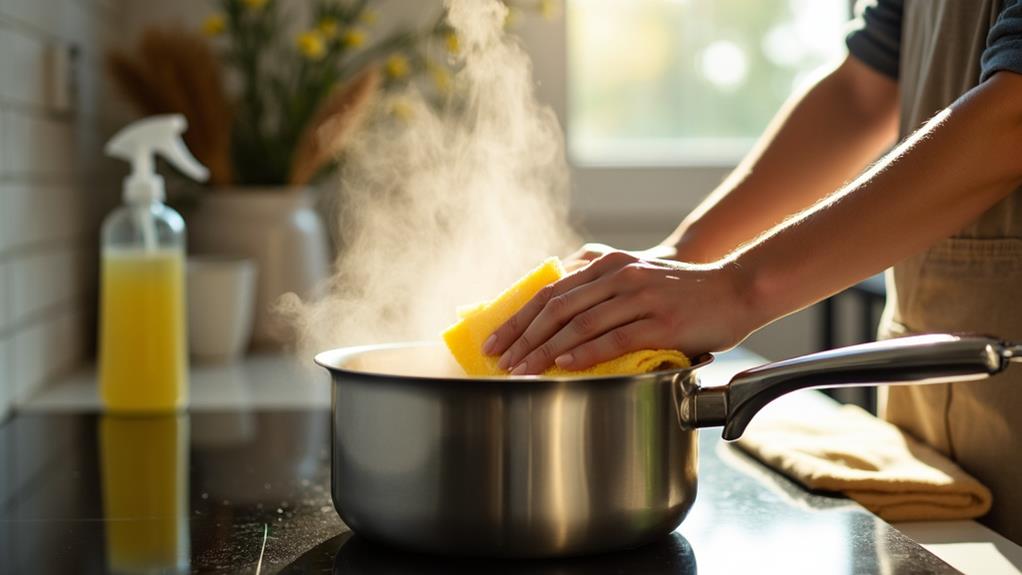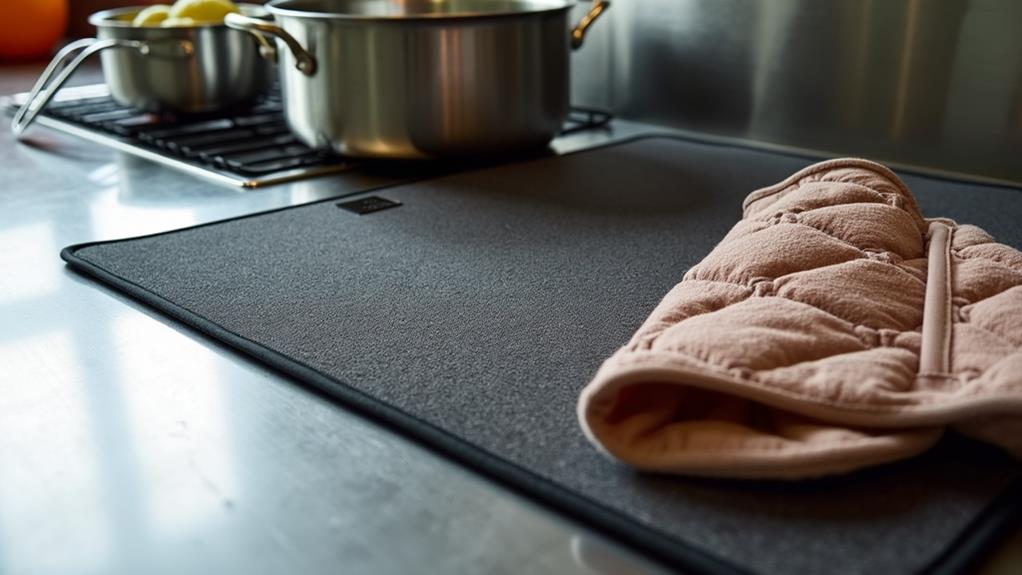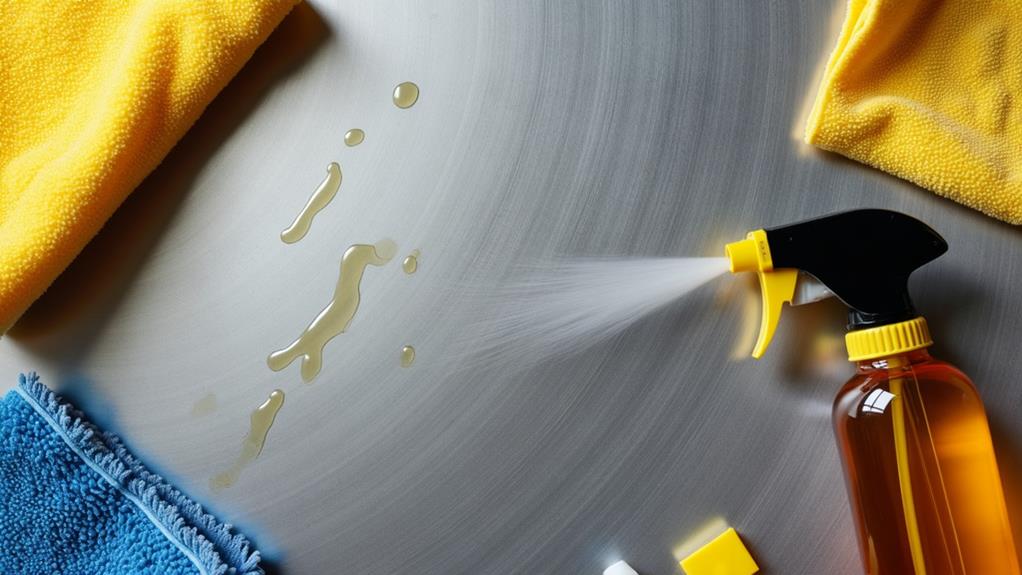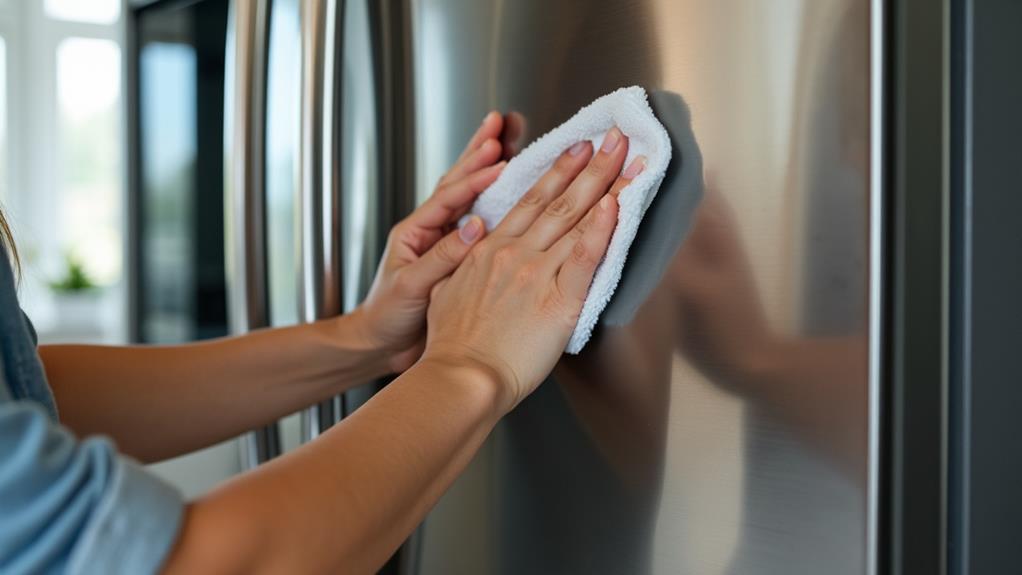How to Remove Grease Stains From Stainless Steel Surfaces
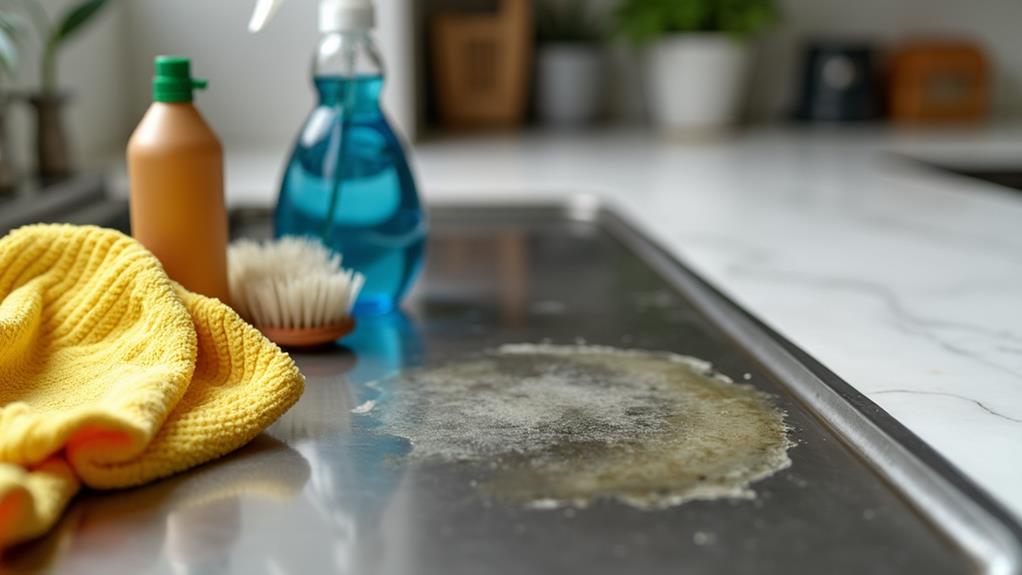
To remove grease stains from stainless steel surfaces, start by mixing equal parts vinegar and water, and apply it directly to the stain for 10-15 minutes. Wipe away the excess with a soft cloth. For tougher stains, use a paste made from three parts baking soda and one part water, scrubbing gently in the direction of the grain. Alternatively, dish soap and warm water work well for fresh stains, or you can use rubbing alcohol for stubborn spots. Always rinse with clean water and dry with a microfiber cloth in the grain's direction. Investigate further techniques to keep your stainless steel gleaming.
Gather Your Supplies
To tackle grease stains on your stainless steel surfaces, you'll need to gather some vital supplies. Start by collecting cleaning tools that are specifically designed for stainless steel. A microfiber cloth is fundamental because it's gentle and won't scratch the surface. Also, grab a non-abrasive sponge to help with tougher spots without leaving marks.
You'll need a mild dish soap or a specialized stainless steel cleaner. These cleaners are formulated to break down grease effectively while preserving the integrity of your stainless steel. Vinegar can also be a good alternative due to its natural degreasing properties. Moreover, keep a spray bottle handy for mixing and applying cleaning solutions.
For stain prevention, consider having a protective spray or polish that can be applied after cleaning. These products create a barrier against future grease stains, making your next cleaning session easier. Don't forget to have a soft, dry towel for the final wipe-down to guarantee no streaks are left behind.
Pre-Treat the Stain
Before diving into the main cleaning process, it's important to pre-treat the stain for effective removal. Different stain types require specific cleaning techniques to guarantee your stainless steel surface remains pristine. By addressing the stain early, you can avoid permanent damage and make the final cleaning easier.
Here's how to pre-treat grease stains:
- Identify the Stain Type: Determine if the grease stain is fresh or has been sitting for a while. Fresh stains are usually easier to remove, while older stains might need more effort.
- Apply a Pre-Treatment Solution: Use a mixture of equal parts white vinegar and water. Vinegar is excellent for breaking down grease and is safe for stainless steel. Spray this solution directly onto the stain, making certain it's fully covered.
- Let it Sit: Allow the solution to sit on the stain for about 10-15 minutes. This gives the vinegar time to penetrate and break down the grease, making it easier to remove later.
- Wipe Away Excess: After the solution has had time to work, use a soft cloth to gently wipe away any excess liquid and loosened grease. This step prepares the surface for the main cleaning process.
Use Dish Soap and Water
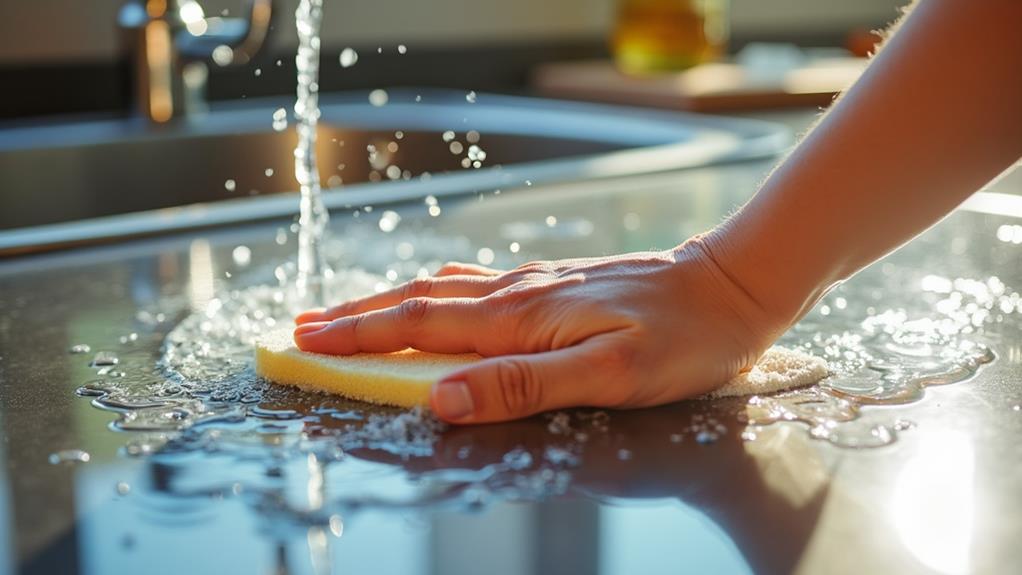
A trusty bottle of dish soap can be your best friend in dealing with grease stains on stainless steel. Start by choosing a high-quality dish soap known for its grease-cutting properties. The effectiveness of dish soap lies in its ability to break down and lift grease from surfaces, making it easier to wipe away.
Begin by filling a bowl with warm water. The water temperature is essential—too cold, and the grease won't dissolve; too hot, and you risk causing damage to the metal. Aim for warm water that's comfortable to touch. Add a few drops of dish soap to the water and mix until it's sudsy.
Next, grab a soft cloth or sponge and dip it into the soapy water. Gently scrub the grease stain, working in the direction of the stainless steel's grain to avoid scratches. You'll notice the grease starting to lift off. Rinse the cloth or sponge frequently in the soapy water to maintain dish soap efficiency.
Once you've removed the stain, rinse the area with clean, warm water to remove any soap residue. Dry the surface with a soft microfiber cloth to prevent water spots. Your stainless steel should now be grease-free and gleaming!
Apply Baking Soda Paste
Baking soda is a versatile and powerful agent for tackling tough grease stains on stainless steel. Its mildly abrasive nature makes it perfect for scrubbing away stubborn marks without scratching the surface. Plus, using baking soda benefits your cleaning routine by making it eco-friendly and cost-effective. Here's how you can make a baking soda paste and use it to keep your stainless steel pristine.
- Mix the Paste: Combine three parts baking soda with one part water in a small bowl. Stir until you get a thick, spreadable paste. The consistency should be similar to toothpaste.
- Apply the Paste: Spread the baking soda paste generously over the grease stain. Make certain to cover the entire area. Let it sit for about 10-15 minutes to allow the paste to break down the grease.
- Scrub Gently: Use a soft cloth or sponge to scrub the paste lightly in the direction of the stainless steel grain. This guarantees you're not causing any scratches while effectively removing the grease.
- Rinse and Dry: Wipe off the paste with a damp cloth and then dry the area thoroughly with a clean towel. This step is essential for stain prevention and maintaining the shine of your stainless steel surface.
Try Vinegar Solution
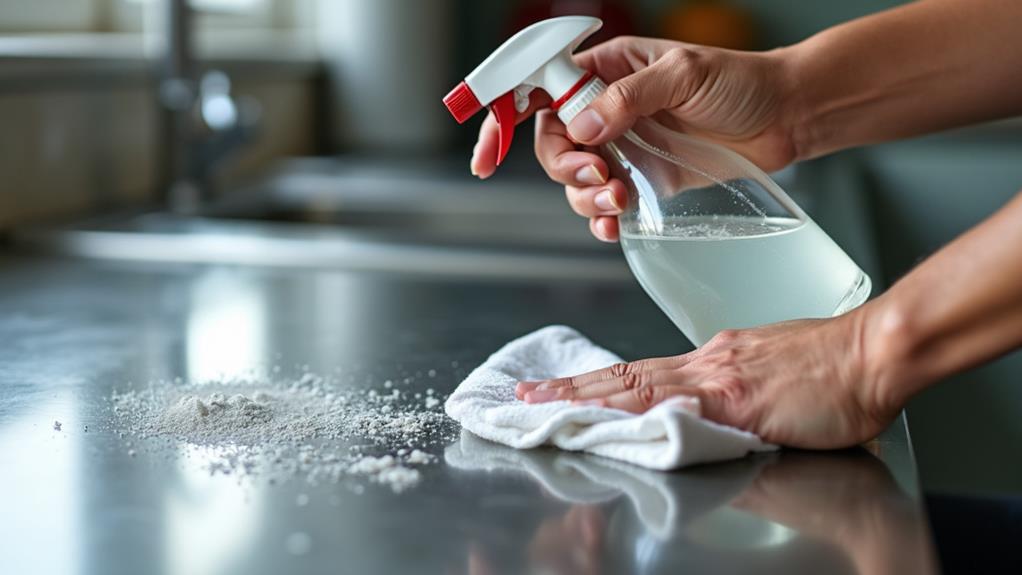
Vinegar's natural acidity makes it an excellent choice for dissolving grease stains on stainless steel. To get started, mix equal parts of white vinegar and water in a spray bottle. Spray the solution directly onto the grease stain and let it sit for a few minutes. The vinegar's acidity will break down the grease, making it easier to wipe away.
One of the vinegar benefits is its natural ability to cut through grime without leaving any residue. After letting the solution sit, use a soft cloth to wipe the area in the direction of the stainless steel grain. This helps maintain the surface's finish and prevents any potential scratches. If the stain persists, you can repeat the process until the grease is fully removed.
Incorporating vinegar into your cleaning routine not only helps with current stains but also plays a role in stain prevention. Regularly cleaning your stainless steel surfaces with vinegar can reduce the buildup of grease over time, making it easier to keep them spotless. Remember, always dry the area thoroughly with a clean towel to avoid water spots. Vinegar is a versatile and effective tool in maintaining the pristine look of your stainless steel surfaces.
Use Rubbing Alcohol
While vinegar is a great solution, rubbing alcohol also works wonders for removing grease stains from stainless steel. This powerful solvent cuts through grease effectively, leaving your surfaces sparkling clean. Here are some key grease removal techniques using rubbing alcohol:
- Gather Supplies: Get a clean, soft cloth, a small bowl, and rubbing alcohol. It's best to use a solution with at least 70% isopropyl alcohol for maximum effectiveness.
- Apply the Alcohol: Pour a small amount of rubbing alcohol onto the cloth. Avoid soaking the cloth; a little goes a long way.
- Wipe the Surface: Gently rub the cloth over the grease-stained area in circular motions. Rubbing alcohol benefits include dissolving grease without leaving streaks.
- Rinse and Dry: After the grease is removed, wipe the area with a damp cloth to remove any residue. Dry the surface thoroughly with a microfiber cloth to prevent water spots.
These simple steps make grease removal a breeze. Rubbing alcohol not only cleans but also disinfects your stainless steel surfaces, ensuring they are both shiny and sanitary. By incorporating these techniques, you'll maintain your stainless steel's pristine appearance effortlessly.
Utilize Commercial Cleaners
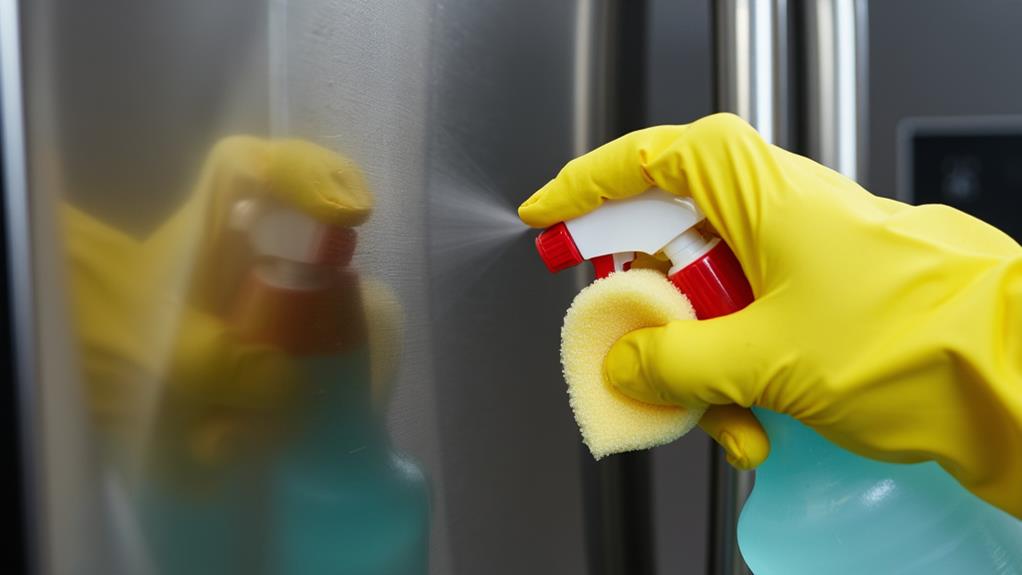
When tackling stubborn grease stains on stainless steel, commercial cleaners can be a highly effective solution. These cleaning products are specifically designed to cut through grease and grime, making your task much easier. You'll find a variety of options on the market, from sprays to wipes, each formulated to handle tough stains.
To start, choose a cleaner that's safe for stainless steel. Read the label to verify it won't damage your surface. Apply the cleaner directly to the stained area, following the product instructions. Often, you'll need to let it sit for a few minutes to break down the grease effectively.
Using a soft cloth or sponge, wipe the area in the direction of the stainless steel grain. This helps avoid scratches and guarantees a thorough clean. For particularly stubborn spots, you might need to apply a bit more elbow grease or repeat the process.
Regularly using these cleaning products not only removes stains but also aids in stain prevention. A routine cleaning regimen will keep your stainless steel surfaces looking pristine and minimize the buildup of grease over time. So, keep a trusted commercial cleaner on hand for quick and efficient maintenance.
Rinse and Dry
After using a commercial cleaner, it's vital to rinse off any residue to prevent streaks and potential damage. Rinse techniques are significant for ensuring that your stainless steel surface remains spotless and free of cleaner buildup. To get the best results, follow these steps:
- Use Clean Water: Take a soft cloth or sponge and soak it in clean, warm water. Gently wipe down the entire area you just cleaned with the commercial product.
- Avoid Excess Water: Make sure not to soak the surface. Excess water can lead to water spots, so wring out your cloth or sponge well before wiping.
- Change Water Frequently: If you're rinsing a large area, change your water frequently to avoid spreading any remaining cleaner residue.
After rinsing, it's time to focus on drying methods. Proper drying prevents water spots and keeps your surface shiny.
- Dry with a Microfiber Cloth: Use a clean, dry microfiber cloth to wipe down the surface. Microfiber is excellent for absorbing moisture without scratching.
- Follow the Grain: Always dry in the direction of the stainless steel grain to avoid streaks and maintain a polished look.
- Buff to Shine: After drying, use a separate dry part of the microfiber cloth to buff the surface for extra shine.
- Check for Spots: Inspect the area for any missed spots and re-dry them as needed.
These rinse techniques and drying methods will leave your stainless steel looking immaculate.
Maintain Stainless Steel
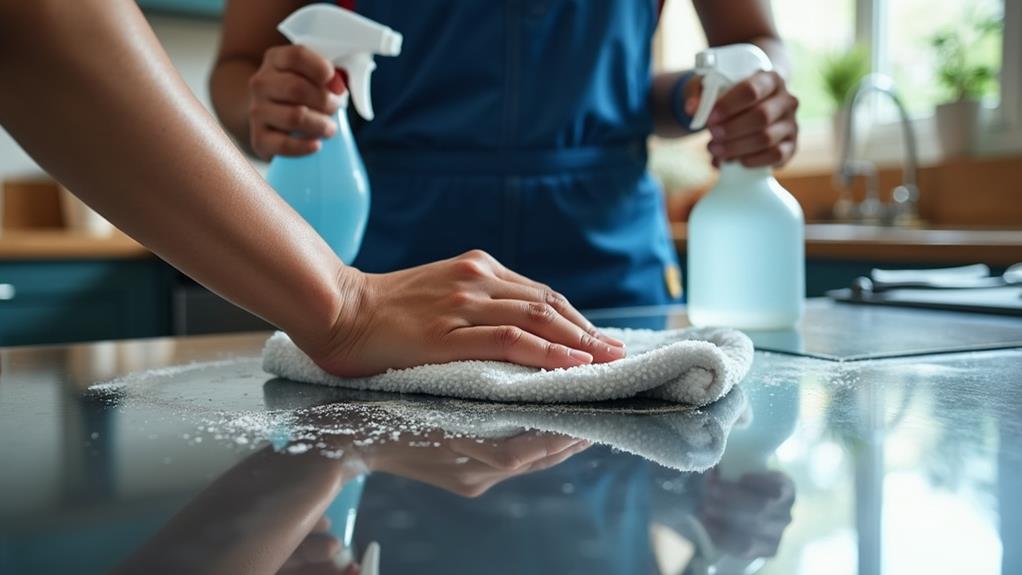
Regular maintenance is vital to keep your stainless steel looking pristine and prolong its lifespan. Start by wiping down the surface with a damp microfiber cloth regularly. This simple action helps to remove fingerprints, dust, and minor smudges before they become stubborn stains.
For deeper cleaning, mix a mild dish soap with warm water. Dampen a cloth or sponge with this soapy solution and gently wipe the stainless steel surface. Be certain to follow the grain of the steel to avoid scratches. Rinse the area with clean water and dry it thoroughly with a microfiber cloth. This routine is fundamental for effective stainless steel maintenance.
To improve surface protection, consider applying a thin layer of stainless steel polish or olive oil. Rub it in with a soft cloth, following the grain. This not only keeps the surface shiny but also creates a protective barrier against future stains and smudges.
Avoid using abrasive cleaners or steel wool, as these can damage the finish. Also, steer clear of chlorine-based cleaners, which can corrode stainless steel. By incorporating these simple steps into your routine, you'll make certain your stainless steel surfaces remain spotless and well-protected.

